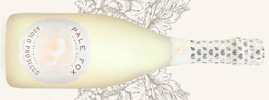Pale Fox Prosecco: what is Single Estate Prosecco?

What’s the hype about this new “Single Estate” Prosecco on the market? What does that mean? Does it match up to the lavish branding and price tag? In short, yes.
I first came across Pale Fox on Facebook, which began to pop up multiple times a week with its sleek bottle design and alluring name. I soon took notice, after all, I am the target market. Not long after, it began surfacing in newspapers and various lifestyle magazines. The hype train was well and truly off. Especially when renowned critic James Suckling gave it a 93-point score, making it the highest scoring Prosecco in the world.
Single Estate seems to be a new phrase they have coined and is a little bit of a play on the term Single Vineyard, which is commonly seen in well established wine regions and upcoming regions trying to establish their point of difference. The appellations of Burgundy, Champagne, even Greece and Croatia, are full of single vineyard examples, so designated to reflect that this wine specifically reflects the soils and climate in that very tiny spot. Part of the reason this suits Pale Fox so well is the area of Prosecco it is from. Many will know the upgraded Prosecco name, Conegliano-Valdobbiadene, which comes from a hilly zone within Prosecco between these two towns, but Asolo is relatively unknown, comprising a mere 3% of production.
Although the winemaking history of this small area goes back thousands of years, Asolo was only granted DOCG status in 2009. It is a hilly area recognized for its terroir, great biodiversity, superior growing conditions and superior Prosecco. It receives sunlight and warmth during the day to help the grapes ripen and experiences cool nights which maintain acidity in the grapes, making them full-flavoured, but balanced, for the final wine.

Pale Fox take a number of steps to ensure their wine is even better. Harvest is incredibly selective and yields are controlled to maximise the vines’ focus on fewer grapes. They also don’t rush the importance of fermentation which, if done over time, imparts more flavour and helps the sparkle integrate much more finely.
To taste, it is swaying more towards a Champagne (partly down to the longer fermentation) than a Prosecco. Hints of bread dough and brioche underly the entire palate, whilst delicate more Prosecco-like flavours rise to the fore. Citrus fruits abound and white flowers and floral elements intermingle. The finish is long and the bubbles creamy.
So, if you fancy treating yourself to a British favourite tipple - as we drink so much Prosecco in the UK - but upping your game, this is the perfect Prosecco to do this with. Both the taste and the bottle itself will impress and delight.

This blog was written by our wine expert, David Andrews. Read his Instagram blog @oinosattheoikos
Updated 13th March 2025